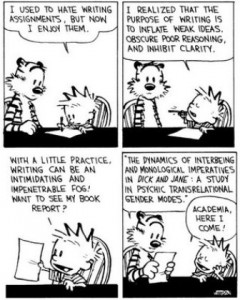During the practicum there were many instances where I observed classroom teachers encouraging academic writing development as discussed in this week’s chapter. One of the most effective strategies I found in terms of student understanding and applicability is an essay outline developed by my sponsor English teacher. The structure addresses a typical literary analysis essay, breaking down into one thesis supported by 2-3 premises, each of which is supported by at least 2 proofs which are then linked back to the thesis through explicit explanations and analyses. The premise is defined by the teacher as a literary tool such as character, plot, atmosphere, etc. which form the topics of the body paragraphs of the essay; within each body paragraph, proofs — or textual evidence mostly in the form of direct quotations — are given, explained and analysed with respect to the thesis. The teacher went over this outline with three different classes: IB English 11 as well as regular English 11 and 12.
I felt this outline was effective mostly in how prescribed and methodical it was; the way the teacher presented it was almost scientific. He did stress though that top marks require more than the bare structure given. He gave some examples of where students could show their own creative flair such as in their use of language and sentence variation. In terms of addressing the needs of ELLs, I feel that giving such a solid and detailed structure for the typical English essay is extremely helpful in orienting these students who may be unfamiliar with the English academic writing style.
Lucy Yang
